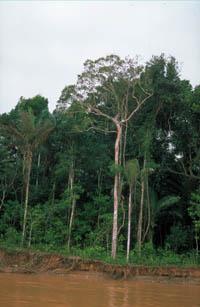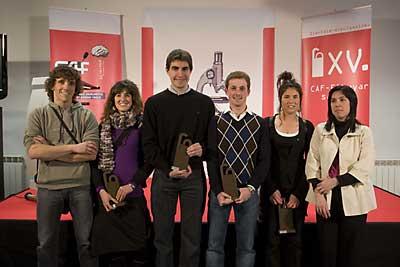Tinder, sparks that light forests
2009/04/01 Aizpurua Arrieta, Ostaizka - Biologia-ikaslea | Alberdi Estibaritz, Antton - Biologia-ikaslea Iturria: Elhuyar aldizkaria
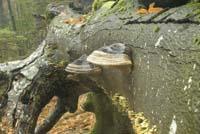
The trees, at each time of their lives, perform various functions in the ecosystem. In youth they are food of many herbivores, while in adulthood their thick bowls are home to many animals. Like all living beings, the strongest and largest plants have points of weakness, and in nature the viruses, bacteria, insects and fungi that have the bow and arrow prepared for them do not lose their opportunity.
Among these beings, those who have the most influence on plants and their environment are fungi. From the ecological point of view, the fungi are divided into three large groups: symbionts that grow in interaction with the plants, parasites that feed on tissues of living plants and saprofites that feed on dead organic matter. Among these last two are the irons that feed on wood from tree trunks.
The Nozzle is the common name given to a series of fungi of polyporal order and similarly, called polyporoid, such as Phaeolus, Trametes, Ganoderma, Fomes and Phellinus. These fungi feed on the wood, for which they form gigantic systems of tubes called mycelium, inside the trunks of the trees, some around the skin and others until the carpenters, which completely damage the tree. The rotting of the wood produces great changes in its composition, which affects the tree and its surroundings. The characteristics and general structure of the trunk change, and this new situation is taken advantage of by numerous animals that cannot use the tree under normal conditions, to build, feed and make life in the shelter. Thus, when the tree begins to rot, it can be said that around it the spark of life is lit.
Wood Wood
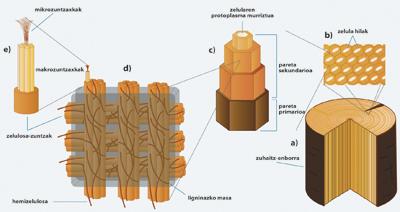
To understand the influence of the sheep on the trunks it is essential to know the structure of the wood. The wood is formed by accumulation of transport elements in the plants that suffer an increase of thickness. As most of the cells that make up the wood are dead, there is no more than their wall. These walls are layers of complex polymers. Between these layers, the primary wall and the secondary wall are distinguished. The first occurs after the division of plant cells and is formed by pectin, hemicellulose and cellulose. The secondary wall only appears in certain cells, between the primary wall and the cell membrane. The wall is usually thicker than the primary one and consists mainly of cellulose, hemicellulose and lignin. Depending on the cell, cutin, suberine and other compounds may also appear.
The wood, therefore, consists of three main compounds: cellulose, hemicellulose and lignin. The three compounds are very different.
Cellulose Pulp
It is the main polymeric compound of the walls of vegetable cells. Its chemical structure is very simple, since it is formed by a simple union of sugar molecules. This association, however, is articulated in a hierarchical way: microfibers are joined in fibrils and these in cellulose fibers. Despite its simple chemical structure, the joints between molecules allow to develop a very complex form.
Hemicellulose Hemicellulose
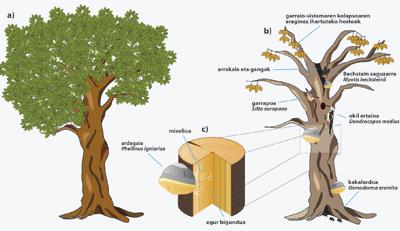
Unlike cellulose, hemicellulose is a long, ramified polymer formed by the binding of several sugars, which appears dispersed throughout the cell wall. It is located associated with cellulose fibres without following any specific organizational pattern. Not all types of hemicellulose are placed in structures as organized as cellulose, so they are more accessible to beings that degrade wood.
Lignin Lignin
Lignin is one of the most difficult to degrade compounds of which are formed in nature and has as main function to give rigidity to cellulose fibers. Fill the cellulose fibres and the grooves between hemicellulose, giving consistency to the wood. Few beings have managed to exploit lignin. It is undoubtedly one of the main compounds that make up the wood, the most difficult to deteriorate and, therefore, the one that lasts longer in the structure of the trunk.
Putrefaction of wood
The process of rotting the wood is long and complex. Different types of living beings participate, but undoubtedly fungi are the beings that play the most important role in the deterioration of dead trunks. About a quarter of the dead organic matter that reaches the ground is wood, but few living beings are able to exploit it directly as food. According to the compounds that are degraded, three types of rot are distinguished.
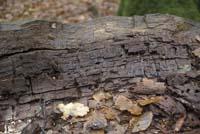
The putrefaction of the lowest level of aggression is known as soft rot. Fungi that cause this type of putrefaction only affect wood with high degree of humidity and low amount of lignin. They exploit cellulose and, above all, hemicellulose, but the action is not very violent, nor the consequences are very high. As their own name indicates, they cause the softening of the wood. Microscopic fungi are responsible for this rot.
Brown putrefaction fungi also exploit cellulose and hemicellulose, but their action is much harder and can affect almost all kinds of woods. By degrading hemicellulose with special enzymes, oxygenated water is released, thereby losing all the cellulose and hemicellulose of the wood. In this case lignin persists. This irregular rot gives rise to fracture lines that divide the wood into several cubic parts. There are sheep that cause this type of rot, like the oak nozzle ( Daedalea quercina ).
The most aggressive process is known as white rot. In this case, in addition to cellulose and hemicellulose, lignin is also annulled. The deterioration of the three compounds is not simultaneous and lignin is degraded after the exploitation of the other compounds. Therefore, first the wood is softened, then the root is produced and finally the total deterioration occurs. The fungi that cause this type of rot are called lignocellulitic, and in this group most sheep are included. The Concordant Notch ( Gibbosa Trays ), the Notch Pipe ( Ganoderma lucidum ) and the Woodworking Yoke ( Fomes fomentarius ) are known, among others. Putrefaction does not occur throughout the tree and in many cases can be localized. That is, the aforementioned processes can occur in a certain part of the tree before it dies.
Effects of rotting
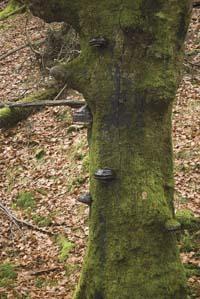
In each phase of the wood putrefaction process, new possibilities are created for animals. When starting to soften the wood, the skin is usually released from the trunk. The spaces that remain between wood and skin are a paradise for many crustaceans and insects, and the forest bats (Barbastella barbastellus) use them as a colony garrison. The softening of the wood increases the possibilities of perforation of the wood to the birds, which becomes more evident in the case of the medium peak (Dendrocopos medius), in danger of extinction in the Basque Country. Compared to the rest of the birds, the neck and beak are quite weak and is not able to drill many types of trees in good condition. In addition, the bird hole does not only exploit birds, such as ticks (Sitta europaea) and mammals, such as the bat Bechstein (Myotis bechsteinii), use them as guards.
In the second phase of putrefaction, the exploitation of hemicellulose and almost all cellulose produces small cracks in the wood. They also take advantage of this animal phenomenon as the common bat of night ( Nyctalus noctula ) and the common charcoal ( Parus palustris ). As these cracks grow, the larger animals also use the holes and vaults that form in the trunk. There are several nocturnal birds of prey that use these trees as a nest. The Osmoderma eremita beetle, considered vulnerable all over the world, also needs the holes that are produced by the rotting of oak trunks in order to develop the larvae.
In many cases, in the holes and vaults, with rotten wood and substances provided by the wind, rather thick substrata are formed. This allows the creation of plants known as epiphytes, that is, on other plants, without being parasites, other plants are developed.
In this process of deterioration of trees, insects also take advantage of their possibilities. The softening of the wood makes it easier for insects to make colonies and guards in the tree. In addition, they are active agents of the deterioration of insects, since many of them feed on the components of the wood. When insects form galleries in the trunk, the air penetrates inside, which significantly alters the conditions of the interior of the trunk. In other cases, the notch itself is used as a shelter. In this way, a great opportunity is created for birds that feed on insects inside the wood.
Finally, once the maximum level of rotting of the wood is reached, the pieces of rotten wood begin to fall to the ground, where the process of deterioration of the wood ends. The little remaining organic matter is mixed with the soil and forms a humus, used for cultivation by other vegetable species that will fill the hollow yielded by the old tree.
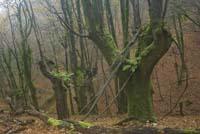
Forest management management
The forests, throughout history, have been used in Euskal Herria to exploit resources of direct interest to the human being. In the Middle Ages, due to the enormous boom of the shipyards, the autochthonous forests were used for the use of wood, as well as for the obtaining of fertilizer leaves and acorns and chestnuts for human and animal feeding. Although initially the original structure of the forest was maintained, little by little the human being adapted the sketches in his own way, which caused the homogenization and impoverishment of the forests. XX. In the eighteenth century, in addition, the native forests have been discarded for the benefit, above all, of the radiate pine (Pinus radiata) and the eucalyptus (Eucalyptus globulus) brought from outside.
The old and semi-rotten trees have had no value for the human being, since their harvest is not fruitful and the quality of the wood is also modest. In this contrast to the interests, the mares are on the other side, since the trees of a certain size, elaborated in time, are essential for life.
The mountain wood, the useless force and the reason of the poor, all equally. This is what the lord of Leitza said, who used the suitor to heat the house, in a time when it was not even intuited that the exterior was cooling by heating the house itself.
Today, however, it is essential to put an end to this conflict between the interests of man and enemies, if we want to continue to observe species and others in our forests. The bat of Bechstein, the bat of forest, the medium peak, the beetle of Osmoderma eremita, are animals in danger of extinction due to the lack of resources that explode, and it is in our hands to channel the future of these animals by The future of many species of nozzle is not guaranteed either, and if these are lost, it will be impossible to recover the ancient and varied forests that we lost. Without changing the mentality we have had and have with forests, it will be difficult to guarantee the future of all these beings.
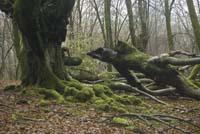
There is the key. Complex networks and endless interactions, derived from the magical dust that was formerly used to ignite the fire under ventisca. A fungus, two trees, three animals. The spark necessary to ignite the forest.
Thanks to Arturo Elosegi for loosing the knot and Andrés Alberdi for binding the edges of the thread. www.euskalnatura.net/ardagai

Gai honi buruzko eduki gehiago
Elhuyarrek garatutako teknologia




